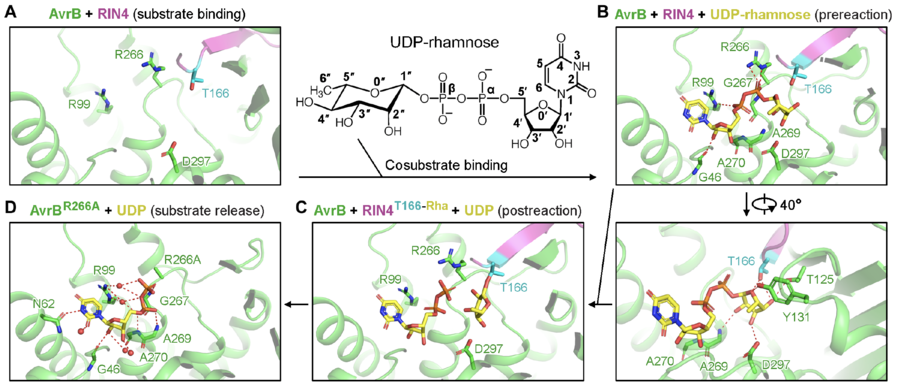CAZypedia celebrates the life of Senior Curator Emeritus Harry Gilbert, a true giant in the field, who passed away in September 2025.
CAZypedia needs your help!
We have many unassigned pages in need of Authors and Responsible Curators. See a page that's out-of-date and just needs a touch-up? - You are also welcome to become a CAZypedian. Here's how.
Scientists at all career stages, including students, are welcome to contribute.
Learn more about CAZypedia's misson here and in this article. Totally new to the CAZy classification? Read this first.
Glycosyltransferase Family 138
This page has been approved by the Responsible Curator as essentially complete. CAZypedia is a living document, so further improvement of this page is still possible. If you would like to suggest an addition or correction, please contact the page's Responsible Curator directly by e-mail.
| Glycosyltransferase Family GT138 | |
| Clan | Fido fold |
| Mechanism | Inverting |
| Active site residues | Known |
| CAZy DB link | |
| https://www.cazy.org/GT138.html | |
Family features
GT138 family of glycosyltransferase is exemplified by AvrB [1]. AvrB contains a Fido domain (Fig. 1A) [2, 3], different from other known glycosyltransferases containing folds of GT-A, GT-B, GT-C, lysozyme-type, GT101, and GT108 (Fig. 1B) [4, 5, 6, 7].
Interestingly, Fido proteins can also be enzymes with activities of AMPylation [8], phosphorylation [9], UMPylation [10], and phosphocholination [11, 12]. Hence, AvrB is a unique Fido protein that functions as a glycosyltransferase.

Substrate specificities
As a bacterial effector from the plant pathogen Pseudomonas syringae, AvrB utilizes host UDP-rhamnose (or dTDP-rhamnose in vitro) as a co-substrate to rhamnosylate the host protein RIN4 and causes the programmed cell death (namely hypersensitive response) [1, 13].
Kinetics and Mechanism
In the reaction, rhamnose is directly transferred to the side chain of a threonine of RIN4, T166 (Fig. 2) [1]. The rhamnosylation reaction catalyzed by AvrB does not require divalent cations (e.g., Mg2+) [1].

Catalytic Residues
A threonine (T166) from the protein substrate directly attacks the rhamnose moiety in the co-substrate, UDP-rhamnose (Fig. 2) [1]. The threonine is close to a histidine and a threonine in AvrB, which may stabilize the acceptor. UDP-rhamnose is stabilized by a few residues in the pocket (Fig. 2) [1].
Three-dimensional structures
AvrB represents the prototype for glycosyltransferases of Fido fold (Fig. 1A) [1]. AvrB contains a large internal domain between helix α2 and helix α3 (Fig. 1A) [1, 2, 3, 14]. AvrB shares similar structural features with other Fido proteins despite the primary sequences are divergent [3].
Family members
AvrB is the only well-studied member so far in the GT138 family [1].
Family Firsts
The first member of GT138 family shown to be a glycosyltransferase is AvrB [1].
The first structure of GT138 family is AvrB (Fig. 1A) [2]. A few AvrB structures are available to reveal the catalysis mechanisms [1, 2, 14]
References
Error fetching PMID 19503829:
Error fetching PMID 19039103:
Error fetching PMID 24141193:
Error fetching PMID 22504181:
Error fetching PMID 21822290:
Error fetching PMID 23572077:
Error fetching PMID 35536922:
Error fetching PMID 25023666:
Error fetching PMID 31513773:
Error fetching PMID 11955429:
Error fetching PMID 15016364:
Error fetching PMID 17397263:
- Error fetching PMID 38354245:
- Error fetching PMID 15016364:
- Error fetching PMID 19503829:
- Error fetching PMID 35536922:
- Lairson LL, Henrissat B, Davies GJ, and Withers SG. (2008). Glycosyltransferases: structures, functions, and mechanisms. Annu Rev Biochem. 2008;77:521-55. DOI:10.1146/annurev.biochem.76.061005.092322 |
- Error fetching PMID 25023666:
- Error fetching PMID 31513773:
- Error fetching PMID 19039103:
- Error fetching PMID 24141193:
- Error fetching PMID 22504181:
- Error fetching PMID 21822290:
- Error fetching PMID 23572077:
- Error fetching PMID 11955429:
- Error fetching PMID 17397263: